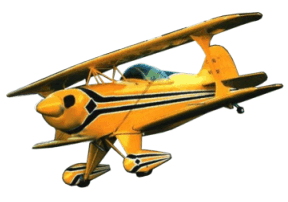Pitts Airplane
History in Brief.
|
1945
The Pitts Special. This was a rigid gear airplane with 55 to 90 hp.
The headrest was set into the turtledeck forming the aft shape of the fuselage. |
1946
This was the second plane in the Pitts legacy which became known as the Little
Stinker. It had longer wings, bungee cord landing gear and used an
aluminum top on the turtledeck. This plane used the Continental C-85
Engine.
|
1950 to 1951
This aircraft was called the Black Magic which used an 0 - 290 125 hp engine. |
1959 to 1960
The S-1C came to life. This was the first plans built Pitts airplane.
It used a 100 to 180 hp engine. The S1-C used an M-6 airfoil. It was
the airplane that became a standard at aerobatic competitions around the
country. It used a two aileron system in which only the bottom wing had
ailerons. Many home modifications also had the upper wing with ailerons
also. |
1967
The S-1S was born. The second "S" stood for a symmetrical airfoil which
enabled the plane to fly as well upside down as it did right side up. Some
pilots found that the plane would actually climb better inverted. The
fuselage was also three inches longer than the early "C" models.
Click here to buy plans for this
aircraft. 1967 also found another version of the Pitts dubbed the S-1D |
1971 to 1982
The introduction of the S-2A which is a Two Place airplane with a I0-360 engine
pumping out 200 hp. This model used the Frieze ailerons where the last 50
or so received the symmetrical ailerons with longer gear and a wider
fuselage. |
1973 to 1981
Was a Factory Built S-1S. |
1979
This was an S-2A modified to become a single place airplane. It used a 260
hp AEI0-540 engine.
The "E" model also surfaced about this time. The S-1SE, S-2E were
partially built Pitts Airplanes with all of the metal parts finished and painted
and you had to build the wings. |
1981
This is the Factory Built S-1T which is really an S-1S modified to use the 200
hp I0-360 engine with a constant speed prop. |
1981 to 1999
This was the S-2B which was essentially the S-2A with a wider fuselage and four
inch longer gear. The top wing was also moved ahead and it sported the
pressure cowl with cowl flaps. It also had the front seat moved four
inches ahead and a new bucket seat installed making it much more comfortable. |
1993
The first major change in many years introducing the Pitts Model 11 Super
Stinker. The Super Stinker uses a six cylinder 0-540 engine. This
plane introduced new Super Stinker "SS" aileron technology a allows a high roll
rate and light pressures without centering sensitivities or the use of spades.
The S-1-11B is Aviat's cosmetic modification to the Super Stinker that
straightens out many of the lines of the plane. Aviat has the plans for
this plane. |
1996
The Model 12 Macho Stinker which uses a 360 to 400 hp, Russian, radial engine.
This plane has a two place cockpit which is bigger than the S-2B which allows
larger people to enjoy aerobatics more easily. Plans and Kits are
available from Kimball Enterprises.
Click Here to go to Kimball Enterprises. |
1999
This is a Curtis designed Super Stinker wing set for the S-1C which allows a
much higher roll rate.
|
1999
S-2C. This plane had a Hartzell three blade composite prop. This
plane is the most refined Pitts to date and was super light with quick ailerons
and is perfectly square with the same pressures required for both inside and
outside maneuvers. |
2003
The Model 14 came into view. It also uses a Russian built radial engine.
|
|
From the Webmaster. I was first introduced to the Pitts by my friends
Roger and Brent Smith. Roger was my flight instructor and mentor and I
appreciate all of the extra effort that he put forth to increase my knowledge of
aerobatic aircraft including the Pitts. C. Jeff Dyrek. |

